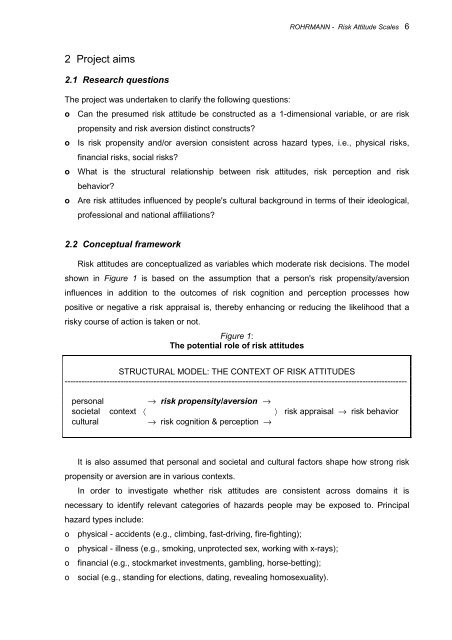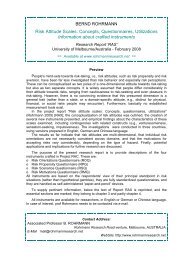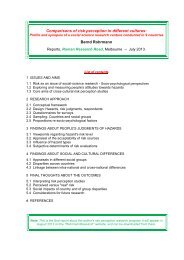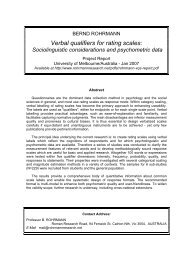Risk Attitude Scales: Concepts, Questionnaires, Utilizations
Risk Attitude Scales: Concepts, Questionnaires, Utilizations
Risk Attitude Scales: Concepts, Questionnaires, Utilizations
You also want an ePaper? Increase the reach of your titles
YUMPU automatically turns print PDFs into web optimized ePapers that Google loves.
2 Project aims<br />
2.1 Research questions<br />
The project was undertaken to clarify the following questions:<br />
ROHRMANN - <strong>Risk</strong> <strong>Attitude</strong> <strong>Scales</strong> 6<br />
o Can the presumed risk attitude be constructed as a 1-dimensional variable, or are risk<br />
propensity and risk aversion distinct constructs?<br />
o Is risk propensity and/or aversion consistent across hazard types, i.e., physical risks,<br />
financial risks, social risks?<br />
o What is the structural relationship between risk attitudes, risk perception and risk<br />
behavior?<br />
o Are risk attitudes influenced by people's cultural background in terms of their ideological,<br />
professional and national affiliations?<br />
2.2 Conceptual framework<br />
<strong>Risk</strong> attitudes are conceptualized as variables which moderate risk decisions. The model<br />
shown in Figure 1 is based on the assumption that a person's risk propensity/aversion<br />
influences in addition to the outcomes of risk cognition and perception processes how<br />
positive or negative a risk appraisal is, thereby enhancing or reducing the likelihood that a<br />
risky course of action is taken or not.<br />
Figure 1:<br />
The potential role of risk attitudes<br />
STRUCTURAL MODEL: THE CONTEXT OF RISK ATTITUDES<br />
---------------------------------------------------------------------------------------------------------------------------<br />
personal → risk propensity/aversion →<br />
societal context 〈 〉 risk appraisal → risk behavior<br />
cultural → risk cognition & perception →<br />
It is also assumed that personal and societal and cultural factors shape how strong risk<br />
propensity or aversion are in various contexts.<br />
In order to investigate whether risk attitudes are consistent across domains it is<br />
necessary to identify relevant categories of hazards people may be exposed to. Principal<br />
hazard types include:<br />
o physical - accidents (e.g., climbing, fast-driving, fire-fighting);<br />
o physical - illness (e.g., smoking, unprotected sex, working with x-rays);<br />
o financial (e.g., stockmarket investments, gambling, horse-betting);<br />
o social (e.g., standing for elections, dating, revealing homosexuality).





